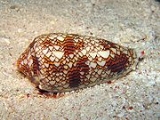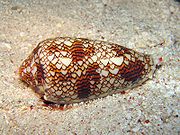
Contryphan
Encyclopedia
The contryphans are a family of peptide
s that are active constituents of the poisonous venom
produced by cone snail
(genus conus
). The two amino acid cysteine
residues in contryphans are linked by a disulfide bond
. In addition, contryphans undergo an unusual degree of post-translational modification including
epimerization of leucine
and tryptophan
, tryptophan bromination, amidation of the C-terminus, and proline hydroxylation
.
 Contryphan family members include:
Contryphan family members include:
where the sequence
abbreviations stand for:
and the remainder of the letters refer to the standard one letter abbreviations for amino acids.
of their fish prey. The molecular target has not been determined for all contryphan peptides, however it is known that contryphan-Vn is a Ca2+-dependent K+ channel
modulator, while glacontryphan-M is a L-type calcium channel
blocker.
Peptide
Peptides are short polymers of amino acid monomers linked by peptide bonds. They are distinguished from proteins on the basis of size, typically containing less than 50 monomer units. The shortest peptides are dipeptides, consisting of two amino acids joined by a single peptide bond...
s that are active constituents of the poisonous venom
Venom
Venom is the general term referring to any variety of toxins used by certain types of animals that inject it into their victims by the means of a bite or a sting...
produced by cone snail
Cone snail
Conidae is a taxonomic family of minute to quite large sea snails, marine gastropod molluscs in the superfamily Conoidea.The snails within this family are sophisticated predatory animals...
(genus conus
Conus
Conus is a large genus of small to large predatory sea snails, marine gastropod molluscs, with the common names of cone snails, cone shells or cones. This genus is placed in the subfamily Coninae within the family Conidae. Geologically speaking, the genus is known from the Eocene to the Recent ...
). The two amino acid cysteine
Cysteine
Cysteine is an α-amino acid with the chemical formula HO2CCHCH2SH. It is a non-essential amino acid, which means that it is biosynthesized in humans. Its codons are UGU and UGC. The side chain on cysteine is thiol, which is polar and thus cysteine is usually classified as a hydrophilic amino acid...
residues in contryphans are linked by a disulfide bond
Disulfide bond
In chemistry, a disulfide bond is a covalent bond, usually derived by the coupling of two thiol groups. The linkage is also called an SS-bond or disulfide bridge. The overall connectivity is therefore R-S-S-R. The terminology is widely used in biochemistry...
. In addition, contryphans undergo an unusual degree of post-translational modification including
epimerization of leucine
Leucine
Leucine is a branched-chain α-amino acid with the chemical formula HO2CCHCH2CH2. Leucine is classified as a hydrophobic amino acid due to its aliphatic isobutyl side chain. It is encoded by six codons and is a major component of the subunits in ferritin, astacin and other 'buffer' proteins...
and tryptophan
Tryptophan
Tryptophan is one of the 20 standard amino acids, as well as an essential amino acid in the human diet. It is encoded in the standard genetic code as the codon UGG...
, tryptophan bromination, amidation of the C-terminus, and proline hydroxylation
Hydroxyproline
-4-Hydroxyproline, or L-hydroxyproline , is a common non-proteinogenic amino acid, abbreviated as HYP, e.g., in Protein Data Bank.-Structure and discovery:...
.
Family members

| Peptide | Sequence | Species | Reference |
|---|---|---|---|
| Des(Gly1)contryphan-R | COwEPWC-NH2 | C. radiatus | |
| Contryphan-R | GCOwEPWC-NH2 | C. radiatus | |
| Bromocontyphan-R | GCOwEPXC-NH2 | C. radiatus | |
| Contryphan-Sm | GCOwQPWC-NH2 | C. stercusmuscarum | |
| Contryphan-P | GCOwDPWC-NH2 | C. purpurascens | |
| Contryphan-R/Tx | GCOwEPWC-NH2 | C. textile Conus textile Conus textile, common name the cloth of gold cone is a venomous species of sea snail, a marine gastropod mollusk in the family Conidae, the cone snails, cone shells or cones. The species is extremely dangerous to humans.-Distribution:C... |
|
| Contryphan-Tx | GCOWQPYC-NH2 | C. textile | |
| Contryphan-Vn | GDCPwKPWC-NH2 | C. ventricosus | |
| Leu-contryphan-P | GCVlLPWC-OH | C. purpurascens | |
| Leu-contryphan-Tx | CVlYPWC-NH2 | C. textile | |
| Glaconryphan-M | NγSγCPWHPWC-NH2 | C. marmoreus Conus marmoreus Conus marmoreus, common name the "marbled cone", is a species of predatory sea snail, a marine gastropod mollusk in the family Conidae, the cone snails, cone shells or cones. This is a species which is believed to feed mostly on marine molluscs including other cone snails. This snail is venomous,... |
where the sequence
Peptide sequence
Peptide sequence or amino acid sequence is the order in which amino acid residues, connected by peptide bonds, lie in the chain in peptides and proteins. The sequence is generally reported from the N-terminal end containing free amino group to the C-terminal end containing free carboxyl group...
abbreviations stand for:
- O = 4-trans-hydroxyprolineHydroxyproline-4-Hydroxyproline, or L-hydroxyproline , is a common non-proteinogenic amino acid, abbreviated as HYP, e.g., in Protein Data Bank.-Structure and discovery:...
, - l = D-leucine, L = L-leucine,
- w = D-tryptophan, W = L-tryptophan,
- γ = gamma-carboxyglutamic acid,
- NH2 = C-terminal amidation
and the remainder of the letters refer to the standard one letter abbreviations for amino acids.
Mechanism of toxicity
The venom of cone snails cause paralysisParalysis
Paralysis is loss of muscle function for one or more muscles. Paralysis can be accompanied by a loss of feeling in the affected area if there is sensory damage as well as motor. A study conducted by the Christopher & Dana Reeve Foundation, suggests that about 1 in 50 people have been diagnosed...
of their fish prey. The molecular target has not been determined for all contryphan peptides, however it is known that contryphan-Vn is a Ca2+-dependent K+ channel
Calcium-activated potassium channel
Calcium-activated potassium channels are divided into BK channels, IK channels, and SK channels based on their conductance ....
modulator, while glacontryphan-M is a L-type calcium channel
L-type calcium channel
The L-type calcium channel is a type of voltage-dependent calcium channel. "L" stands for long-lasting referring to the length of activation. Like the others of this class, the α1 subunit is the one that determines most of the channel's properties....
blocker.

